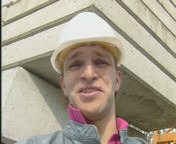Distributed Video Coding
Distributed video coding is a new compression paradigm based on
two key Information Theory results: the Slepian-Wolf and Wyner-Ziv
theorems. Those results suggest that it is possible to compress two
statistically dependent signals in a distributed way (separate
encoding, jointly decoding) using a rate similar to that used in a
system where the signals are encoded and decoded together, i.e. like
in traditional video coding schemes. This theoretical framework is
referred as lossy source coding with side information at the decoder
(Wyner-Ziv) and enables to shift the complexity from the encoder to
the decoder.
Future work should be posted here.
Improving the Quality of the Side Information:
The IST wyner-ziv video codec generates the side information
by using motion compensated frame interpolation algorithms at
the decoder. Besides forward and bidirectional motion
estimation, a spatial motion smoothing algorithm to eliminate
motion outliers is proposed (see Figure bellow). This allows
significant improvements in the rate-distortion (RD) performance
without sacrificing the encoder complexity.
 
J. Ascenso, C. Brites, F.
Pereira, "Improving Frame Interpolation with Spatial Motion
Smoothing for Pixel Domain Distributed Video Coding", 5th
EURASIP Conference on Speech and Image Processing, Multimedia
Communications and Services, Slovak Republic, July 2005. (paper)
(presentation)
J. Ascenso, C. Brites, F. Pereira, "Motion
Compensated Refinement for Low Complexity Pixel Based
Distributed Video Coding", IEEE International Conference on
Advanced Video and Signal Based Surveillance, Como, Italy,
September 2005. (paper) (poster) L. Natário, C. Brites, J. Ascenso, F. Pereira,
“Side Information Extrapolation for Low-Delay Pixel-Domain
Distributed Video Coding”, International Workshop on Very Low
Bitrate Video, Sardinia, Italy, September 2005. (paper)
Intra mode decision for Wyner-Ziv Video Coding:
The quality of the motion-interpolation
estimate is not constant across the whole frame. In this work is
assumed that covered/uncovered regions, illumination changes and
camera noise do affect significantly the quality of the motion
interpolation image and therefore is necessary to encode some
regions in intra-frame mode when correlation with the side
information is weak. The Figure bellow illustrates the mode
decision map performed at the encoder (low-complexity decision).
Greyed areas refer to Wyner-Ziv blocks.
 
A. Trapanese, M. Tagliasacchi, S. Tubaro, J. Ascenso, C. Brites,
F. Pereira, "Embedding a Block-based Intra Mode in Frame-based
Pixel Domain Wyner-Ziv Video Coding", International Workshop on
Very Low Bitrate Video, Sardinia, Italy, September 2005. (paper)
|

![]()



